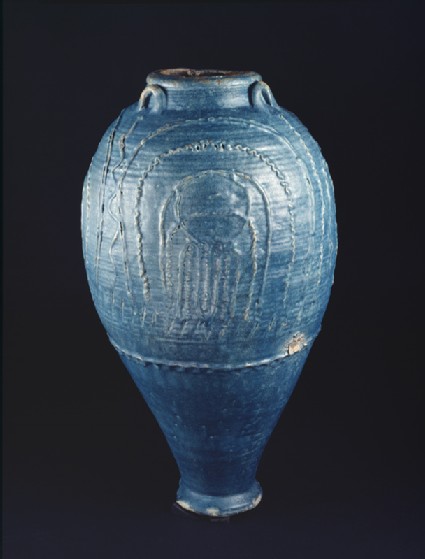Highlights: 35 objects
- Reference URL
Actions
Storage jar
-
Description
The rise of Islam was accompanied by a major expansion in manufacturing and trade. Thousands of jars such as this one were produced for storing and transporting goods, like date honey. They were essentially functional objects, and it was almost certainly the content of the jars, rather than the jars themselves, that was valued in this trade.
This example is particularly impressive because of its size and aesthetic appeal. Being 77 cm tall, it would have been thrown in two sections and joined in the middle. It was made in Iraq in the 8th to 9th century. This kind of glazed ware predates Islam, and illustrates the simple, functional foundation upon which more inventive and creative glazing techniques were developed across the Islamic world.
Fragments of this type of jar have been found around the Persian Gulf, down the East African coast, around the coast of India and South-East Asia, and as far as China and Japan. Only a few dozen have survived intact.
-
Details
- Associated place
- Date
- 8th - 9th century AD (AD 701 - 900)
- Material and technique
- earthenware, with applied decoration under a turquoise glaze
- Dimensions
- 77 cm (height)
- Material index
- Technique index
- Object type index
-
container › vessel › jar › storage-jar
- No. of items
- 1
- Credit line
- Purchased with the assistance of the Miller Bequest, 2005.
- Accession no.
- EA2005.85
-
Further reading
Fukai, Shinji, Ceramics of Ancient Persia, trans. Edna B. Crawford, photographs by Bin Takahashi (New York: Weatherhill and Kyoto: Tankosha, 1981), cat. p. 108
Glossary (2)
earthenware, glaze
-
earthenware
Ceramic material made of clay which is fired to a temperature of c.1000-1200⁰c. The resulting ceramic is non-vitreous and varies in colour from dark red to yellow.
-
glaze
Vitreous coating applied to the surface of a ceramic to make it impermeable or for decorative effect.
Location
Objects are sometimes moved to a different location. Our object location data is usually updated on a monthly basis. Contact the Jameel Study Centre if you are planning to visit the museum to see a particular object on display, or would like to arrange an appointment to see an object in our reserve collections.
Galleries
Collection trails
© 2013 University of Oxford - Ashmolean Museum




